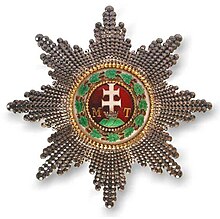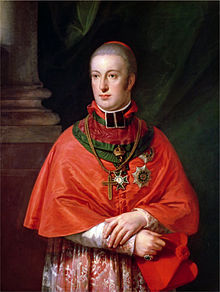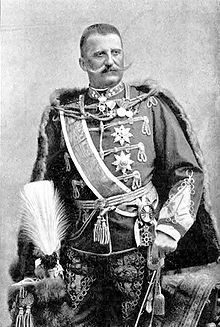| Order of Saint Stephen | |
|---|---|
 Grand Cross insignia with Collar | |
| Awarded by | |
| Type | Dynastic order |
| Established | 1764 |
| Royal house | House of Habsburg-Lorraine |
| Religious affiliation | Roman Catholic |
| Sovereign | Archduke Karl |
| Grand Master | Archduke Georg |
| Classes | Grand Cross Commander Knight |
| Precedence | |
| Next (higher) | Military Order of Maria Theresa |
| Next (lower) | Order of Leopold (Austria) |
Ribbon of the order | |
The Order of Saint Stephen (Hungarian: Szent István rend) was an order of chivalry founded in 1764 by Maria Theresa. In 1938, Miklós Horthy took the rights and activities of Grand Master as Regent of Hungary. The name of the Order changed to the Royal Hungarian Order of Saint Stephen (German: Königlich Ungarischer Sankt-Stephans-Orden, Latin: Ordo Equitum Sancti Stephani Regis (Hungariae) Apostolici). The Order was terminated at the time of the proclamation of the Second Hungarian Republic in 1946. It was recreated in 2011 as the Hungarian Order of Saint Stephen, and to this day remains the highest order in Hungary.[1][2][3]


The order is named after Hungary's most famous king, Stephen I, whose reign (997–1038) was marked by his consolidation of the monarchy, the establishment of the medieval state of Hungary,[4] and his adoption of Christianity as the state religion. His coronation, as recognized in the Church, is dated 1001.[5] He died August 15, 1038, during the Feast of the Assumption. His feast day in Hungary is August 20. Canonized by Pope Gregory VII in 1083 along with his son Imre (who preceded him in death in 1031, after a hunting accident) and Bishop Gerhard of Hungary, St. Stephen is the patron saint of "Hungary, kings, the death of children, masons, stonecutters, and bricklayers." Though its exact provenance is somewhat disputed, the Crown of St. Stephen is said to have been a gift from Pope Silvester II, upon Stephen's 1001 coronation.[6]


Empress Maria Teresa and her son, Emperor Joseph II, made several political concessions to ease tensions within their empire—most especially between Austria and Hungary, among them being the creation of the Order. Membership was available to various members of the Hungarian nobility. To receive the Order, according to collector and historian Stephen Herold,
one had to have at least four quarterings of arms showing as many generations of noble status. It helped promote her (Maria Teresa's) position as Queen of Hungary and reinforced the quasi independent position of Hungary in the Empire. The original statutes allow for only 20 Grand Crosses, 30 Commanders and 50 Knights who are to be "distinguished for virtue and merit and noble birth". Grand Cross Knights were considered so important that the Emperor was to address them as "Cousin". These insignia were to be returned to the Chancellery of the Order on the death of the holder. There was no military application of this order. It is rare, and even modern awards of St. Stephen are seldom seen. Perhaps more than any other Austrian order, this one approached the ideal character as put forth in its statutes and regulations.
|
Main page: Category:Recipients of the Order of Saint Stephen of Hungary |














After the dissolution of Austria-Hungary, Hungary and Austria could not make a legal agreement on the rights of the Order. The base of the argument was whether Maria Theresa founded the Order de jure as the sovereign of Hungary, or the sovereign of Austria, or as Holy Roman Empress. In 1938, when Austria as a de jure successor state of Austria-Hungary ceased to exist by becoming part of Germany, Horthy issued an addendum to be attached on 4 November 1938 to the statutes of the Order which declared that as long as the Regent was the head of the Kingdom of Hungary, he also held the powers and duties of the Grand Master.